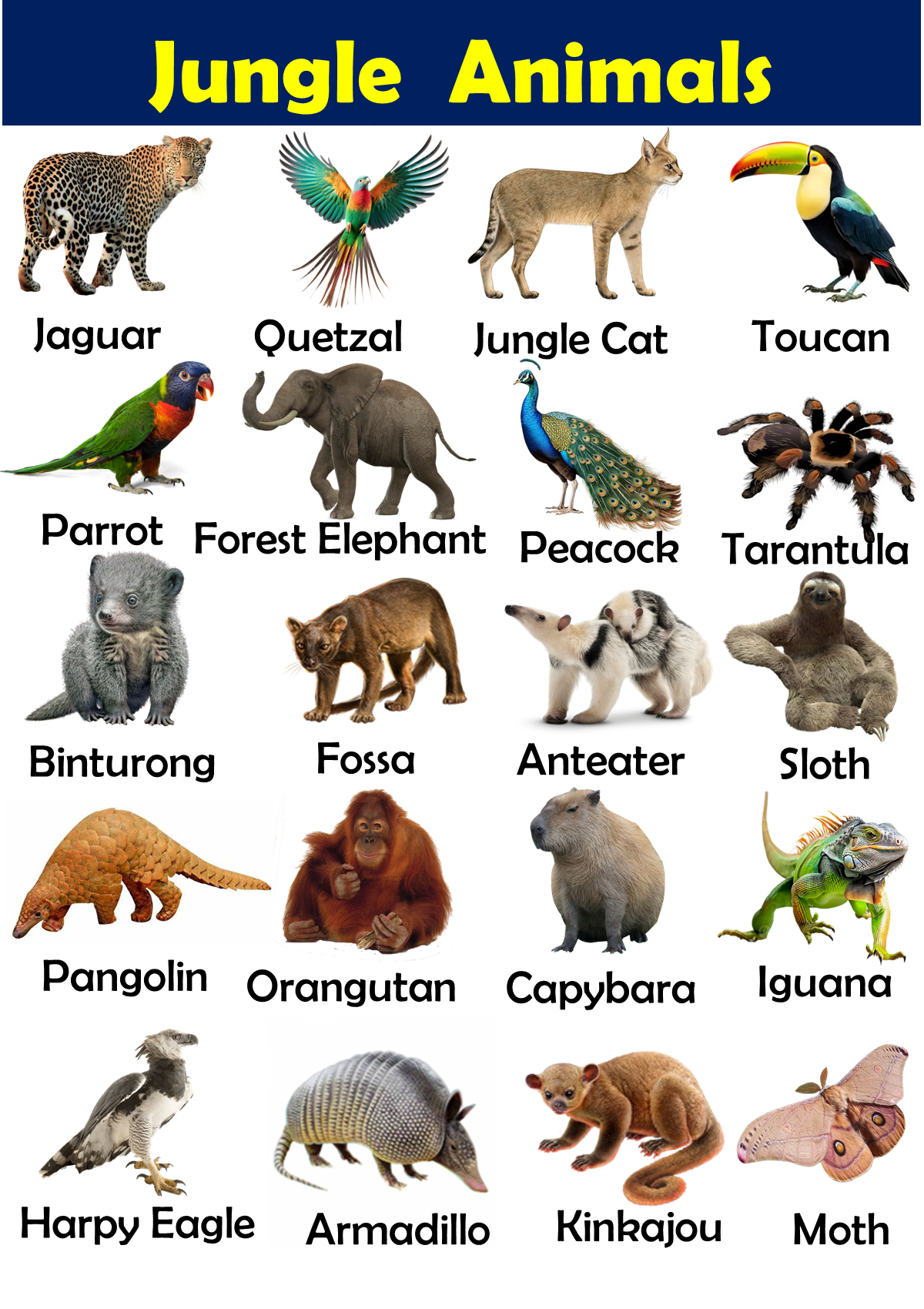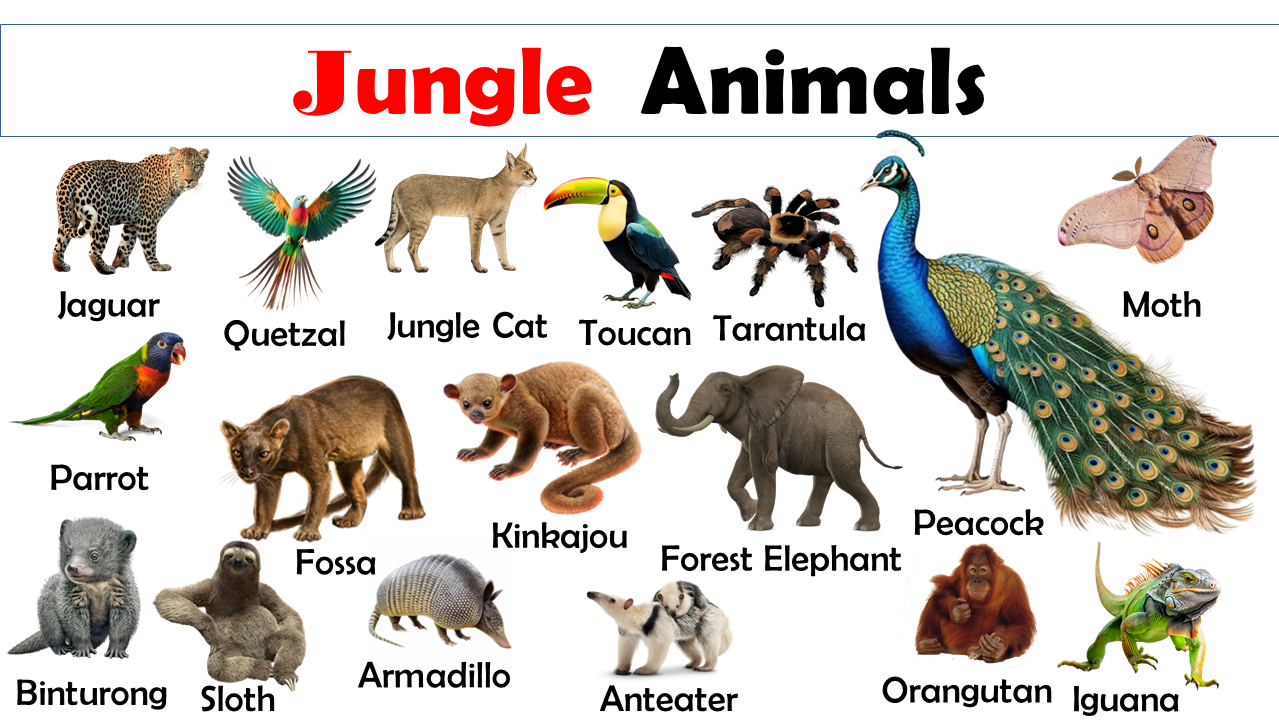Jungle animal vocabulary bustling, vibrant place filled with a variety of animals that each play a special role in their ecosystem. In this blog post, we will explore the fascinating world of jungle animals. From the tiniest insects to the mighty jaguars, you’ll learn about who they are, what they eat, and interesting facts about their lives.
This journey will help you grow your English vocabulary with exciting and advanced words about these incredible creatures. Let’s uncover the secrets of jungle animals together!
What are Jungle Animals?
Jungle animals refer to the diverse array of species that inhabit the dense and lush forests around the world, particularly in tropical regions. These ecosystems are characterized by high levels of biodiversity and complex food webs. Animals in these environments have adapted to the dense vegetation and varied climates, from the rainforests of the Amazon to the jungles of Southeast Asia and Central Africa.
List of Jungle Animals
- Jaguar
- Orangutan
- Green Anaconda
- Parrot
- Howler Monkey
- Bengal Tiger
- Gorilla
- Sloth
- Capybara
- Toucan
- Red Panda
- Chimpanzee
- Tarantula
- Python
- Tree Frog
- Leopard
- Macaw
- Tapir
- Iguana
- Spider Monkey
- Harpy Eagle
- Ocelot
- Lemur
- King Cobra
- Aye-Aye
- Bushmaster Snake
- Cassowary
- Tarsier
- Armadillo
- Flying Fox
- Peacock
- Hornbill
- Panther
- Poison Dart Frog
- Okapi
- Mandrill
- Kinkajou
- Gibbon
- Sloth Bear
- Civet
- Pangolin
- Quetzal
- Siamang
- Proboscis Monkey
- Vine Snake
- Leaf Cutter Ant
- Agouti
- Coatimundi
- Javan Rhinoceros
- Puma
- Fruit Bat
- Golden Lion Tamarin
- Anteater
- Forest Elephant
- Sun Bear
- Clouded Leopard
- Boa Constrictor
- Emerald Tree Boa
- Dracula Ant
- Binturong
- Moth
- Borneo Elephant
- Fossa
- Junglefowl
- Pit Viper
- Woolly Monkey
- Eyelash Viper
- Jungle Cat
- Tree Kangaroo
- Komodo Dragon
Explore More Animal Vocab:

Jungle Animals Vocabulary and Their Facts
1. Jaguar
The jaguar is the largest cat in the Americas and the third-largest globally. Found primarily in the Amazon basin, it’s well-adapted to jungle life, often swimming in rivers. Jaguars have incredibly powerful jaws, capable of breaking the shells of armored reptiles and using an unusual killing method: biting directly through the skull of prey.
2. Orangutan
Orangutans are native to the rainforests of Borneo and Sumatra. Known for their intelligence, they spend most of their lives in trees and are the largest animals to do so. These great apes are critically endangered, mainly due to habitat loss caused by deforestation and palm oil cultivation.
3. Green Anaconda
The green anaconda is one of the world’s largest and heaviest snakes, residing in the Amazon and Orinoco basins. It is a skilled swimmer; its coloration camouflages it in murky waters, where it ambushes a variety of prey, including fish, birds, mammals, and even caimans.
4. Parrot
Parrots are known for their vibrant colors and the ability to mimic human speech. These intelligent birds are found in various jungle regions around the world, thriving in dense, tropical environments where their colors blend with the vivid foliage.
5. Howler Monkey
Howler monkeys are famous for their loud howls, which can travel three miles through dense forest. This vocalization helps them mark territory and communicate within the troop. They are the largest of the New World monkeys and live high in the treetops of South and Central American jungles.
6. Bengal Tiger
The Bengal tiger is native to the dense forests of India, Bangladesh, Bhutan, and Nepal. This apex predator is crucial for the ecosystem, helping maintain the balance between prey species and the vegetation upon which they feed. It is known for its beautiful, striking coat and formidable power.
7. Gorilla
Gorillas, particularly the Eastern and Western lowland gorillas, inhabit the dense forests of central Africa. These gentle giants live in groups led by a dominant male and are mostly herbivorous. Gorillas share 98% of their DNA with humans, highlighting their close genetic relationship.
8. Sloth
Sloths are known for their slow movement, spending most of their life hanging upside down in the trees of Central and South American jungles. This lifestyle helps them avoid predators and conserve energy, feeding mainly on leaves and fruit.
9. Capybara
The capybara is the world’s largest rodent, found throughout the forests and wetlands of South America. They are highly social and can be found in groups of up to 100 individuals. These animals are adapted to an aquatic lifestyle, with webbed feet helping them swim efficiently.
10. Toucan
Toucans are recognizable by their large, colorful bills, which despite their size, are surprisingly light due to their hollow structure. They are native to Latin America’s tropical forests, where they primarily feed on fruit, but occasionally eat insects and small lizards.
11. Red Panda
Native to the temperate forests of the Himalayas, the red panda spends most of its time in trees. Its diet mainly consists of bamboo, but it can also eat eggs, birds, and insects. The red panda is often mistaken for a bear but is actually more closely related to raccoons.
12. Chimpanzee
Chimpanzees are found in the jungles and forests of central and West Africa. They are highly social animals, living in communities that can include dozens of individuals. Chimpanzees use a variety of vocalizations, gestures, and facial expressions to communicate.
13. Tarantula
Tarantulas are among the largest spiders in the world, inhabiting the jungle floors. They are primarily nocturnal hunters, preying on insects and small vertebrates. Despite their fearsome appearance, they are generally harmless to humans.
14. Python
Pythons are non-venomous snakes found in the jungles of Africa, Asia, and Australia. They kill by constriction, wrapping their bodies around prey and suffocating it. Pythons are capable of consuming animals larger than themselves thanks to their flexible jaws.
15. Tree Frog
Tree frogs are adapted to life in the jungle canopy, with sticky pads on their toes for climbing. Their vibrant colors can warn predators of toxicity or camouflage them among the leaves and flowers. Tree frogs are indicators of environmental health, with their populations reflecting local ecosystem conditions.
16. Leopard
Leopards are versatile hunters that adapt to various environments, including jungles. Their spotted coat provides camouflage, making them excellent stalkers. They are solitary animals, with territories that can span several miles.
17. Macaw
Macaws are colorful parrots found in Central and South America’s rainforests. Their strong beaks are perfect for cracking nuts and seeds, while their loud calls resonate through the forest. These social birds often pair for life and can live up to 60 years in captivity.
18. Tapir
Tapirs are large browsing mammals that inhabit jungle and forest regions in South and Central America and Southeast Asia. Their prehensile snouts help them grab branches and leaves. Although primarily terrestrial, they are excellent swimmers.
19. Iguana
Iguanas are tree-dwelling lizards found in the rainforests of South and Central America. Their green coloration blends into the leafy environment, providing camouflage from predators. Iguanas are herbivores, feeding on leaves, flowers, and fruit.
20. Spider Monkey
Spider monkeys are among the largest New World monkeys and are named for their long limbs and tail. Highly social, they form large troops that split into smaller groups to forage during the day. They are critical seed dispersers for their ecosystems.
21. Harpy Eagle
The harpy eagle is one of the largest and most powerful eagles, found in tropical rainforests from Mexico to Brazil. Its massive talons can exert several hundred pounds of pressure, enough to crush large mammal bones, which makes it a formidable predator.
22. Ocelot
Ocelots are medium-sized wild cats with strikingly patterned coats, found throughout the rainforests of South and Central America. They are nocturnal and highly territorial, preying on a variety of animals including rodents, birds, and monkeys.
23. Lemur
Lemurs are endemic to Madagascar and inhabit its rainforests. They are highly social, living in groups and communicating with various vocalizations. Lemurs’ diets vary widely, from fruit and flowers to insects and small vertebrates.
24. King Cobra
The king cobra, the world’s longest venomous snake, can be found in the jungles of Southeast Asia. Known for its intelligence and the ability to stand up and look a person in the eye, it primarily feeds on other snakes, including venomous species.
25. Aye-Aye
The aye-aye is a lemur native to Madagascar, known for its distinctive method of finding food. It taps on trees to locate insects, then gnaws holes in the wood using its forward-slanting incisors to extract them with its long middle finger.
26. Bushmaster Snake
The bushmaster is one of the largest venomous snakes in the Americas, found in the dense jungles. It is a pit viper, equipped with heat-sensing pits to detect prey. Despite its fearsome reputation, it is shy and avoids human contact.
27. Cassowary
The cassowary is one of the world’s largest birds, native to the tropical forests of New Guinea and northern Australia. Known for its striking blue and black coloration and helmet-like casque, it can be very aggressive if threatened.
28. Tarsier
Tarsiers are small primates with enormous eyes and incredibly strong hind limbs, native to the jungles of Southeast Asia. Their large eyes provide excellent night vision, crucial for spotting prey like insects and small animals.
29. Armadillo
Several species of armadillos live in the tropical rainforests of South America. Their bony armor provides protection from predators, and they can curl into a ball when threatened. Armadillos are omnivores, feeding on both plants and small invertebrates.
30. Flying Fox
Flying foxes, or fruit bats, are large bats with a wingspan of up to 1.5 meters, found in dense jungle environments of Asia, Africa, and Australia. They play a crucial role in their ecosystems as pollinators and seed dispersers.
